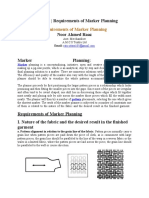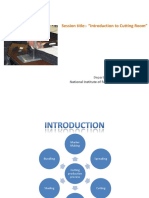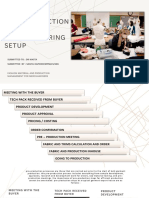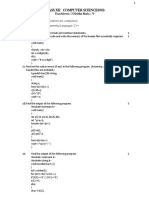L-5 (Marker Making)
Uploaded by
KashfmmCopyright:
Available Formats
L-5 (Marker Making)
Uploaded by
KashfmmCopyright
Available Formats
Share this document
Did you find this document useful?
Is this content inappropriate?
Copyright:
Available Formats
L-5 (Marker Making)
Uploaded by
KashfmmCopyright:
Available Formats
MARKER MAKING/LAY PLAN MAKING
What is a Marker? The Marker is a diagram of a precise arrangement of pattern pieces for the sizes of a specific style that are to be cut from a single spread. What is Marker Making/Lay Plan? Marker making is the process of determining the most efficient layout of pattern pieces for a specified style, fabric, and distribution of sizes. In other words, The cutting templates representing all of the individual components of a garment have to be laid out together in such a way that they fit within the confines of the fabric width as closely and efficiently as possible, in order to minimize waste. This is Lay Plan.
MARKER MAKING/LAY PLAN MAKING
Guide Lines for the Lay Plan The templates have to be laid in a way that takes account of the directional properties of the fabric, such as thread directions, pattern directions, grain of nap or pile. It may also be necessary to allow for matching of stripes, checks, or designs.
So major factors to be considered are:
1. Orientation and Direction 2. Pattern Matching
MARKER MAKING/LAY PLAN MAKING
Guide Lines for the Lay Plan 1. Orientation and Direction The orientation of the pattern templates will depend on the construction of the textile material and its pattern design features. There are three basic types of orientation:
i. Nonwovens ii. Cretonne iii. Corduroy
MARKER MAKING/LAY PLAN MAKING
Guide Lines for the Lay Plan 1. Orientation and Direction
i.
Nonwovens Fabrics for which neither the orientation nor the direction is important. e.g. random-laid nonwoven fabrics.
MARKER MAKING/LAY PLAN MAKING
Guide Lines for the Lay Plan 1. Orientation and Direction ii. Cretonne Fabrics for which the orientation is important but the templates may be laid in either direction. e.g. linings and laminated fabrics.
MARKER MAKING/LAY PLAN MAKING
Guide Lines for the Lay Plan 1. Orientation and Direction iii. Corduroy Fabrics for which orientation and direction are both important. e.g. pile fabrics, fabrics with a directional pattern or pile, knitted fabrics.
MARKER MAKING/LAY PLAN MAKING
Guide Lines for the Lay Plan 2. Pattern Matching The quality of a product is affected significantly by the accuracy of pattern matching. A flawless execution, especially with checks and stripes, demands high consumption of fabric and takes a great deal of time. The coloring, the repeat size, and the prominence of the pattern, as well as the degree of matching between individual garment pieces are crucial in determining the cost and difficulty in making the lay plan, in spreading the cloth, and in cutting. During spreading it is necessary to match the pattern exactly at each end of the lay and in every ply. Cutting may have to be carried out in two stages, with a preliminary rough cut being followed by more precise second cutting together with pattern matching. In making the lay plan the pattern markers cannot be laid in such a way as to minimize cutting waste; they have to be disposed according to the requirement of the fabric pattern.
7
MARKER MAKING/LAY PLAN MAKING
Guide Lines for the Lay Plan 2. Pattern Matching Features of Accurate Pattern Matching: Symmetry The pattern must be symmetrical about the central axis. Examples: left and right front panels, collars backs Vertical Continuity The pattern must not be interrupted or displaced at horizontal seams. Example: pockets
MARKER MAKING/LAY PLAN MAKING
Guide Lines for the Lay Plan 2. Pattern Matching Features of Accurate Matching:
Pattern
Horizontal Continuity The pattern must not be interrupted or displaced at vertical seams or across adjacent parts. Example: arm and front panel Overall Continuity The form and the repeat of the pattern must be maintained across all seams, facings, trimmings, patches, etc. Examples: patch pockets, flaps, darts, facings.
MARKER MAKING/LAY PLAN MAKING
Dimensions of Marker There are two dimensions of marker. Length Width
Markers are used to measure yardage requirement. Marker Efficiency Marker efficiency is basically the area covered by the pattern pieces to the total area of the fabric. Marker efficiency = Area covered by pattern pieces x 100 Total area of spread Efficiency of marker goes up to 95 % in home textiles. Efficiency of marker goes up to 80-85 % in garments.
10
MARKER MAKING/LAY PLAN MAKING
Types of Marker/Lay Plan The types of marker or lay plan being used in the industry are of the following type: Half Garment Lay Whole Garment Lay Single Size Lay
Multi-Size Lay
Sectional Lay Interlocking Lay Mixed Multi-Size Lay
11
MARKER MAKING/LAY PLAN MAKING
Types of Marker/Lay Plan Half Garment Lay This includes only half of the garment pieces (e.g. the right side of the garment). They are used for folded or tubular fabrics and for fabrics which are spread face to face.
Half Garment Lay
12
MARKER MAKING/LAY PLAN MAKING
Types of Marker/Lay Plan Whole Garment Lay All of the garment pieces, left and right sides, are included in the lay. This type of lay is used for open width fabrics.
Full Garment Lay
13
MARKER MAKING/LAY PLAN MAKING
Types of Marker/Lay Plan Single Size Lay
The lay includes all of the pieces for a single size.
Restricting the lay to a single size makes order planning and laying up the fabric easier, but the disadvantage is a somewhat higher material consumption, compared to multi-size lays.
Single Size Lay
14
MARKER MAKING/LAY PLAN MAKING
Types of Marker/Lay Plan Multi-Size Lay Sectional Lay The lay is made in at least two distinct rectangular sections. Each section contains all of the parts of a single size. Adjacent sections may be the same or a different size.
Sectional Multi-size Lay for Two Sizes
15
MARKER MAKING/LAY PLAN MAKING
Types of Marker/Lay Plan Multi-Size Lay Interlocking Lay Two or more sections, one after the other, usually different sizes, but the sections are not confined to strict rectangular areas; the pieces for the different sections may merge at the borders.
Interlocking Multi-size Lay for Two Sizes
16
MARKER MAKING/LAY PLAN MAKING
Types of Marker/Lay Plan Multi-Size Lay Mixed Multi-Size Lay In this case there are no distinct sections; the pieces for the two or more different garment sizes are intermingled. This is the arrangement which normally gives the best material utilization.
Mixed Multi-size Lay for Three Sizes
17
You might also like
- Progressive Safety Gears G01, G11 G21, G211: Inventio AgNo ratings yetProgressive Safety Gears G01, G11 G21, G211: Inventio Ag4 pages
- Carr and Latham's Technology of Clothing ManufactureFrom EverandCarr and Latham's Technology of Clothing ManufactureDavid J. Tyler4/5 (1)
- Marker Planning - Requirements of Marker Planning Noor Ahmed RaazNo ratings yetMarker Planning - Requirements of Marker Planning Noor Ahmed Raaz4 pages
- NIFT Mumbai: Spreading and Cutting of Apparel Products (SCAP) Session 1No ratings yetNIFT Mumbai: Spreading and Cutting of Apparel Products (SCAP) Session 141 pages
- Chapter 2-Capacity Study and Machine LoadingNo ratings yetChapter 2-Capacity Study and Machine Loading9 pages
- Presented By: Rohan.J BFT/15/314: Project-Quality Control in Sewing Department by Increasing Pass Percentage of GarmentsNo ratings yetPresented By: Rohan.J BFT/15/314: Project-Quality Control in Sewing Department by Increasing Pass Percentage of Garments55 pages
- Features of Modular Production System AreNo ratings yetFeatures of Modular Production System Are2 pages
- Points To Be Considered Before Marker MakingNo ratings yetPoints To Be Considered Before Marker Making10 pages
- Apparel Production System Analysis Discussion Handout Introduction To Different Production SystemNo ratings yetApparel Production System Analysis Discussion Handout Introduction To Different Production System32 pages
- Understanding The Global Apparel Manufacturing Process100% (1)Understanding The Global Apparel Manufacturing Process18 pages
- Fabric Loss During Spreading A Comparative Study of The Actual Loss in Manufacturing Men S ShirtsNo ratings yetFabric Loss During Spreading A Comparative Study of The Actual Loss in Manufacturing Men S Shirts12 pages
- Practical Manual: Garment Construction Paper Iii - I Year (Voc)No ratings yetPractical Manual: Garment Construction Paper Iii - I Year (Voc)13 pages
- Denimfabricstextile Cottontrbrush: APPAREL PRODUCTION SYSTEMS (Wholesale Denim Fabrics in CHINA)No ratings yetDenimfabricstextile Cottontrbrush: APPAREL PRODUCTION SYSTEMS (Wholesale Denim Fabrics in CHINA)6 pages
- Improvisation of The Productivity of Morgan Tecnica Cutting MachineNo ratings yetImprovisation of The Productivity of Morgan Tecnica Cutting Machine33 pages
- Sewing Production & Machineries Equpiment: List Down The Operations Performed For Manufacturing The Product100% (1)Sewing Production & Machineries Equpiment: List Down The Operations Performed For Manufacturing The Product45 pages
- Textile Testing & Quality: Title: To Determine The Skewness of The Given FabricNo ratings yetTextile Testing & Quality: Title: To Determine The Skewness of The Given Fabric6 pages
- Sanya Kapoor - Pre - Production Process AssignmentNo ratings yetSanya Kapoor - Pre - Production Process Assignment7 pages
- Marker Planning, Spreading Process & Equipments: Deepika Agarwal, Gayathri V.S, Greeshma V, Santhi BijuNo ratings yetMarker Planning, Spreading Process & Equipments: Deepika Agarwal, Gayathri V.S, Greeshma V, Santhi Biju51 pages
- Spreading and Cutting of Apparel ProductsNo ratings yetSpreading and Cutting of Apparel Products43 pages
- Production Orale en Interaction: Student A Student BNo ratings yetProduction Orale en Interaction: Student A Student B2 pages
- Kioti CS2220NU, CS2520H, CS2520 (N) U, CS2620H, CS2620U Tractor Operator's ManualNo ratings yetKioti CS2220NU, CS2520H, CS2520 (N) U, CS2620H, CS2620U Tractor Operator's Manual15 pages
- Structural Design Project of Super Tall Building Chicago Spire100% (3)Structural Design Project of Super Tall Building Chicago Spire475 pages
- Design of Two-Way Slabs: Project InformationNo ratings yetDesign of Two-Way Slabs: Project Information3 pages
- International Combustion: Di Esel-Electric LocomotiveNo ratings yetInternational Combustion: Di Esel-Electric Locomotive11 pages
- Caterpillar Cat 314D CR and 314D LCR Excavator (Prefix PDP) Service Repair Manual Instant DownloadNo ratings yetCaterpillar Cat 314D CR and 314D LCR Excavator (Prefix PDP) Service Repair Manual Instant Download27 pages
- Class Xii Computer Science (083) : General Instructions - (I) All Questions Are Compulsory (Ii) Programming Language: C++No ratings yetClass Xii Computer Science (083) : General Instructions - (I) All Questions Are Compulsory (Ii) Programming Language: C++7 pages
- Investigation and Analysis of Bridge Pot Bearing: I R J M TNo ratings yetInvestigation and Analysis of Bridge Pot Bearing: I R J M T10 pages
- Pure Technology in A Bottle: The History of A Technological R - EvolutionNo ratings yetPure Technology in A Bottle: The History of A Technological R - Evolution53 pages
- Analysis and Design of Advanced Bus StandNo ratings yetAnalysis and Design of Advanced Bus Stand11 pages
- Invitation Letter - Korea Defense - PT. Tunas HabibiNo ratings yetInvitation Letter - Korea Defense - PT. Tunas Habibi1 page
- Progressive Safety Gears G01, G11 G21, G211: Inventio AgProgressive Safety Gears G01, G11 G21, G211: Inventio Ag
- Carr and Latham's Technology of Clothing ManufactureFrom EverandCarr and Latham's Technology of Clothing Manufacture
- Marker Planning - Requirements of Marker Planning Noor Ahmed RaazMarker Planning - Requirements of Marker Planning Noor Ahmed Raaz
- NIFT Mumbai: Spreading and Cutting of Apparel Products (SCAP) Session 1NIFT Mumbai: Spreading and Cutting of Apparel Products (SCAP) Session 1
- Presented By: Rohan.J BFT/15/314: Project-Quality Control in Sewing Department by Increasing Pass Percentage of GarmentsPresented By: Rohan.J BFT/15/314: Project-Quality Control in Sewing Department by Increasing Pass Percentage of Garments
- Apparel Production System Analysis Discussion Handout Introduction To Different Production SystemApparel Production System Analysis Discussion Handout Introduction To Different Production System
- Understanding The Global Apparel Manufacturing ProcessUnderstanding The Global Apparel Manufacturing Process
- Fabric Loss During Spreading A Comparative Study of The Actual Loss in Manufacturing Men S ShirtsFabric Loss During Spreading A Comparative Study of The Actual Loss in Manufacturing Men S Shirts
- Practical Manual: Garment Construction Paper Iii - I Year (Voc)Practical Manual: Garment Construction Paper Iii - I Year (Voc)
- Denimfabricstextile Cottontrbrush: APPAREL PRODUCTION SYSTEMS (Wholesale Denim Fabrics in CHINA)Denimfabricstextile Cottontrbrush: APPAREL PRODUCTION SYSTEMS (Wholesale Denim Fabrics in CHINA)
- Improvisation of The Productivity of Morgan Tecnica Cutting MachineImprovisation of The Productivity of Morgan Tecnica Cutting Machine
- Sewing Production & Machineries Equpiment: List Down The Operations Performed For Manufacturing The ProductSewing Production & Machineries Equpiment: List Down The Operations Performed For Manufacturing The Product
- Textile Testing & Quality: Title: To Determine The Skewness of The Given FabricTextile Testing & Quality: Title: To Determine The Skewness of The Given Fabric
- Sanya Kapoor - Pre - Production Process AssignmentSanya Kapoor - Pre - Production Process Assignment
- Marker Planning, Spreading Process & Equipments: Deepika Agarwal, Gayathri V.S, Greeshma V, Santhi BijuMarker Planning, Spreading Process & Equipments: Deepika Agarwal, Gayathri V.S, Greeshma V, Santhi Biju
- Production Orale en Interaction: Student A Student BProduction Orale en Interaction: Student A Student B
- Kioti CS2220NU, CS2520H, CS2520 (N) U, CS2620H, CS2620U Tractor Operator's ManualKioti CS2220NU, CS2520H, CS2520 (N) U, CS2620H, CS2620U Tractor Operator's Manual
- Structural Design Project of Super Tall Building Chicago SpireStructural Design Project of Super Tall Building Chicago Spire
- International Combustion: Di Esel-Electric LocomotiveInternational Combustion: Di Esel-Electric Locomotive
- Caterpillar Cat 314D CR and 314D LCR Excavator (Prefix PDP) Service Repair Manual Instant DownloadCaterpillar Cat 314D CR and 314D LCR Excavator (Prefix PDP) Service Repair Manual Instant Download
- Class Xii Computer Science (083) : General Instructions - (I) All Questions Are Compulsory (Ii) Programming Language: C++Class Xii Computer Science (083) : General Instructions - (I) All Questions Are Compulsory (Ii) Programming Language: C++
- Investigation and Analysis of Bridge Pot Bearing: I R J M TInvestigation and Analysis of Bridge Pot Bearing: I R J M T
- Pure Technology in A Bottle: The History of A Technological R - EvolutionPure Technology in A Bottle: The History of A Technological R - Evolution
- Invitation Letter - Korea Defense - PT. Tunas HabibiInvitation Letter - Korea Defense - PT. Tunas Habibi

























































































